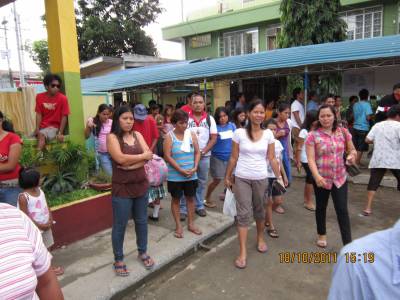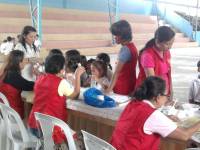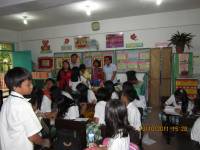12.40 PM Mass Drug Administration on Filariasis! | |
A mass drug administration on Filariasis was conducted last October 18, 2011 from 8:00 a.m. – 5:00 p.m. to teachers, schoolchildren and parents at Vicente Hizon Elementary School by Barangay Hizon Health Workers. Spearheading the activity was Ms. Emily Villagonzalo, RN/Midwife assigned at Barangay Hizon Health Center together with the Barangay Volunteer Health Workers. Present also was Ms. Casandra Alonto Maderse, Population Worker, Population Division, City Health Office, who also conducted simultaneously an Information and Education Campaign (IEC) on Filariases and IEC on Population Program. Filariases is a disease transmitted through mosquito bites and if not avoided, will result to constant fever, severe headache, swelling of feet, legs, thighs, hands, testicles, mammary glands and arms. It will also cause lymph nodes on the iliac area and armpits. A white discoloration of urine will also be evident during the acquisition of the disease. The free medicines dispensed were a combination of Diethylcarbamazine citrate 50mg/tab. and Albendazole 400mg/tab - the dosage depends upon the age of the patient and taken through oral intake. The activity was under the continuing program lined up this year by the City Health and being fully -supported by the Chairman on the Committee of Health and Social Services,
Kagawad Erico R. Talili and the Punong Barangay Ralph O. Abella. Sec Red FILARIASIS IN THE PHILIPPINES 645,232 cases of filariasis (both forms) were estimated for the Philippines during 1963 to 1996 Wuchereria bancrofti: Time and Place: Disease in the Philippines is nocturnally periodic. Prevalence surveys: Vectors: Brugia malayi Time and Place: Vectors: Mass treatment with diethylcarbamazine and albendazole was administered to 1,945,121 persons during 2001. | |
|
| |
Tuesday, 2025.12.02, 9.25 PM
Welcome Guest
Welcome Guest
Main » 2011 October 18 » Mass Drug Administration on Filariasis!


















